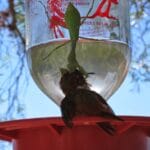It might seem like a David and Goliath scenario, but those delicate hummingbirds visiting your feeder face a surprising threat: the praying mantis. While often viewed as beneficial garden insects, praying mantises are actually formidable predators with a taste for more than just bugs.
Tiny Ninjas, Mighty Appetite
Praying mantises are masters of disguise, blending seamlessly into their surroundings as they lie in wait for unsuspecting prey. Their powerful forelegs, equipped with sharp spines, can snatch a hummingbird right out of the air with lightning-fast reflexes.
While it might sound unbelievable, documented cases and shocking photos, even featured in National Geographic, confirm that praying mantises can and do kill and eat hummingbirds. One study published in The Wilson Journal of Ornithology confirmed mantis attacks on hummingbirds across 13 countries.
[https://www.lolaapp.com/loudest-animal-on-earth-nyt]: Learn more about nature’s fascinating predators.
[https://www.lolaapp.com/marmot-vs-woodchuck]: Discover the surprising world of animal behavior.
Size Isn’t Everything
While a large praying mantis and a hummingbird might be similar in length (around 4 inches), hummingbirds are often twice as heavy. This suggests that mantises likely target smaller hummingbird species. The Giant Hummingbird, measuring 8 inches, is far too large for a mantis to overpower.
Ambush Predators and Opportunistic Dinners
Mantises don’t chase hummingbirds down; they are ambush predators. They prefer to lie in wait near hummingbird feeders, using their camouflage to blend in with foliage and their quick reflexes to snag unsuspecting visitors.
While insects make up the majority of their diet, larger mantis species are opportunistic carnivores. They’ve been known to consume small lizards, frogs, and even mice, demonstrating their ability to take down prey larger than themselves.
Protecting Your Hummingbirds
If you’re a hummingbird enthusiast, don’t panic. While mantis predation is a real threat, it’s not a common occurrence. By taking a few precautions, you can minimize the risk to your backyard hummingbirds:
- Relocate Feeders: Place feeders away from bushes, trees, and dense foliage where mantises like to hide. A distance of at least 6 feet can make a difference.
- Spread Out Feeding Stations: Provide multiple feeders in different areas of your yard. This disperses the hummingbirds, making them less vulnerable to ambush.
- Be Vigilant: Regularly check your feeders and surrounding areas for mantises, especially larger species. If you spot one, consider temporarily removing the feeder until it moves on.
A Complex Relationship: The Bigger Picture
The praying mantis and hummingbird interaction highlights the complexities of the natural world. While mantises provide valuable pest control in our gardens, their predatory instincts extend to hummingbirds, reminding us that even seemingly harmless creatures can pose a threat.
Further research is needed to fully understand the impact of mantis predation on hummingbird populations. Some scientists are investigating whether climate change, which could lead to the expansion of larger mantis species, might pose a greater threat to hummingbirds in the future.
By learning about these fascinating creatures and taking simple precautions, we can help protect the hummingbirds that grace our backyards and appreciate the delicate balance of predator and prey that shapes the natural world around us.
















1 thought on “Hummingbird Feeder Danger: Can Praying Mantises Really Eat Hummingbirds?”
Comments are closed.